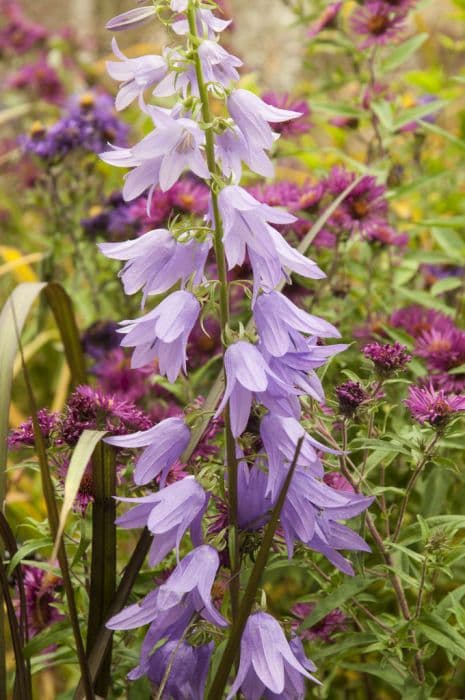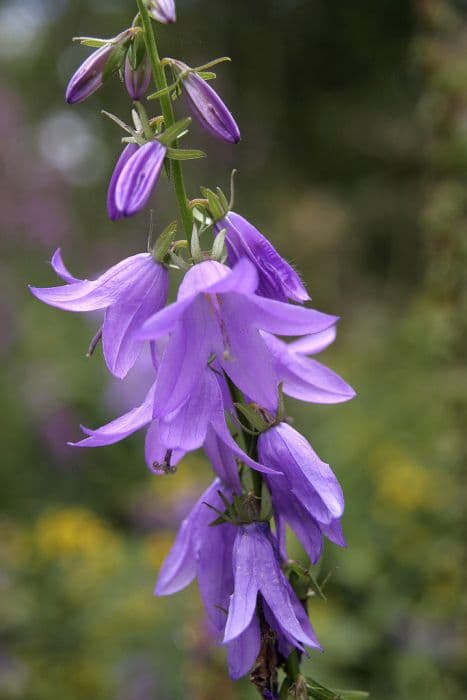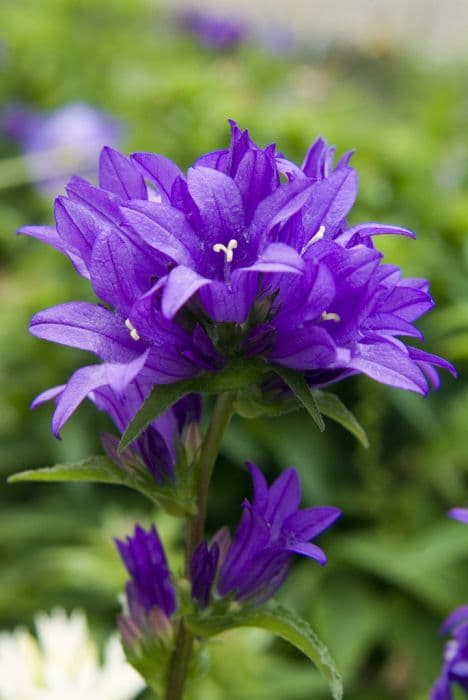Peach-leaved Bellflower Campanula persicifolia 'Cornish Mist'

ABOUT
Campanula persicifolia 'Cornish Mist', commonly known as Peach-leaved Bellflower 'Cornish Mist', has an elegant and delicate appearance. This plant is characterized by its narrow, glossy green leaves, which are similar in shape to those of a peach tree, hence its common name. The foliage forms a low-growing mound or basal rosette from which long, slender stems arise. On top of these stems, the plant displays its stunning bell-shaped flowers. These blooms are a soft lilac to pale blue in hue and gracefully hang or nod, lending an enchanting, cottage garden feel. Each flower is composed of fused petals that create the bell shape, opening at the mouth into a gentle flare with light, almost translucent edging. The inside of the bells often has a faintly speckled pattern, and the delicate texture of the petals gives them an ethereal look. These flowers cluster loosely at the stem's apex, giving the plant an airy, open aspect. The overall growth habit is graceful, with the flower-studded stems rising above the foliage in a charming display. The Peach-leaved Bellflower 'Cornish Mist' blooms throughout early to mid-summer, and if deadheaded after the initial flush of flowers, it can continue to produce blooms intermittently. The contrast between the soft flower colors and the dark, lush greenery of the leaves is visually pleasing, making it a beloved choice for borders, flower beds, and as an accent in gardens seeking to achieve a romantic ambience.
About this plant
 Names
NamesFamily
Campanulaceae
Synonyms
Peach-Leaved Bellflower, Willow Bell, Peach Bells, Fairy Bellflower
Common names
Campanula persicifolia 'Cornish Mist'.
 Toxicity
ToxicityTo humans
Peach-leaved bellflower is generally not considered toxic to humans. However, as with many plants, individual sensitivities can vary. If symptoms of an allergic reaction or gastrointestinal upset occur after handling or ingesting any part of the plant, seek medical attention.
To pets
Peach-leaved bellflower is generally not considered toxic to pets. While it is not known to be poisonous, pets may still experience mild stomach upset if they ingest large amounts of the plant. As with any non-food plant, it is advisable to prevent pets from consuming it to avoid potential digestive issues. If you suspect your pet is showing symptoms after ingestion, such as vomiting or diarrhea, consult your veterinarian.
 Characteristics
CharacteristicsLife cycle
Perennials
Foliage type
Semi-deciduous
Color of leaves
Green
Flower color
White
Height
2-3 feet (60-90 cm)
Spread
1-2 feet (30-60 cm)
Plant type
Herb
Hardiness zones
3
Native area
Europe
Benefits
 General Benefits
General Benefits- Attracts Pollinators: Campanula persicifolia 'Cornish Mist', also known as Peach-leaved Bellflower, attracts bees and butterflies which are beneficial for pollination in the garden.
- Low Maintenance: It is known for being relatively easy to care for, requiring minimal maintenance once established.
- Ornamental Beauty: Produces beautiful, nodding bell-shaped flowers that enhance the visual appeal of any garden space.
- Drought Tolerance: Once established, it has moderate drought tolerance making it suitable for gardens with less frequent water availability.
- Long Blooming Period: Offers a long season of blooms, often from late spring to early summer, adding color to the garden for an extended period.
- Cold Hardy: The Peach-leaved Bellflower is cold-hardy, making it suitable for cooler climates and able to survive frosty conditions.
- Border Planting: Its upright habit and height make it a good choice for borders or as a backdrop in flower beds.
- Cottage Garden Appeal: Ideal for cottage garden design, contributing to a relaxed and traditional aesthetic with its charming flowers.
- Cut Flowers: The flowers make excellent cut flowers for bouquets and arrangements, lasting well in a vase.
- Wildlife Habitat: Provides habitat and resources for various insects, contributing to biodiversity in the garden.
 Medical Properties
Medical PropertiesThis plant is not used for medical purposes.
 Air-purifying Qualities
Air-purifying QualitiesThis plant is not specifically known for air purifying qualities.
 Other Uses
Other Uses- Photography Subject: With its delicate white blooms, Campanula persicifolia 'Cornish Mist' is an excellent subject for photographers specializing in botanical themes.
- Fairy Gardens: Its ethereal appearance makes the Peach-leaved Bellflower a favorite in miniature fairy garden designs, providing a whimsical touch.
- Artistic Inspiration: Artists may use the elegant form and color of Peach-leaved Bellflower as a source of inspiration for paintings, drawings, or textile designs.
- Educational Tool: Botany educators can use the Peach-leaved Bellflower to teach students about plant morphology and reproductive structures.
- Culinary Garnish: The flowers of the Peach-leaved Bellflower can be used as an edible decoration on salads and desserts for a touch of elegance.
- Craft Projects: Dried flowers and stems of the Peach-leaved Bellflower can be incorporated into homemade paper, giving it a unique and natural texture.
- Dye Production: The petals of the Peach-leaved Bellflower can be used in natural dye-making processes for fabrics and textiles, yielding subtle colors.
- Bookmark Material: Pressed flowers of the Peach-leaved Bellflower can be laminated and used as bookmarks, offering a unique and organic design.
- Wedding Confetti: Dried petals of the Peach-leaved Bellflower can be tossed as biodegradable confetti at weddings, providing a natural and eco-friendly option.
- Garden Education Centers: The plant can be used in demonstration gardens that focus on native and non-invasive plant species, teaching visitors about responsible gardening practices.
Interesting Facts
 Feng Shui
Feng ShuiThe Peach-leaved Bellflower is not used in Feng Shui practice.
 Zodiac Sign Compitability
Zodiac Sign CompitabilityThe Peach-leaved Bellflower is not used in astrology practice.
 Plant Symbolism
Plant Symbolism- Gratitude: The Campanula, commonly known as Bellflower, is often associated with gratitude. This is because these delicate blooms can express appreciation and thankfulness towards someone.
- Constancy: As Bellflowers frequently grow in the same spot year after year, they symbolize constancy and perennial love, implying an unchanging nature of affection.
- Everlasting Love: Bellflowers, with their enduring and perennial character, also symbolize everlasting love, suggesting a love that can stand the test of time.
- Humility: The natural nodding form of the Bellflower's blossoms has been interpreted as a sign of humility, often conveying a message of modesty or submission.
- Hope: With their charming and upward facing blooms, Bellflowers can signify hope, representing optimism and looking positively toward the future.
 Water
WaterThe Peach-leaved Bellflower should be watered deeply, ensuring that the soil is moist but not waterlogged. It should be watered when the top inch of soil feels dry to the touch, which generally equates to once a week, depending on climate conditions. During particularly hot and dry spells, watering frequency may need to be increased. A good method is to water at the base of the plant, avoiding overhead watering to prevent leaf diseases. In terms of amount, aim for about 1 to 1.5 gallons per week for an established plant, adjusting as necessary for temperature and rainfall.
 Light
LightPeach-leaved Bellflower thrives in full sun to partial shade. The ideal location would receive morning sunlight and afternoon shade, especially in hotter climates. Too much shade will cause the plant to grow leggily and reduce blooming, while too much sun can stress the plant during peak summer heat.
 Temperature
TemperaturePeach-leaved Bellflowers are hardy and can survive temperatures as low as 20°F once established. The optimal temperature range for vigorous growth and bloom is between 60°F and 75°F. They can withstand some summer heat if adequately watered but prefer cooler conditions.
 Pruning
PruningPeach-leaved Bellflower benefits from pruning to remove spent flowers, which encourages further blooming and prevents self-seeding if not desired. After the main bloom in early summer, cut back the flower stalks to promote a second bloom in late summer or early fall. Prune back the foliage in late fall to prepare the plant for winter and maintain a tidy appearance.
 Cleaning
CleaningAs needed
 Soil
SoilPeach-leaved bellflower thrives best in well-draining, loamy soil rich in organic matter with a pH range of 6.0 to 7.5. Amend garden soil with compost or peat moss to enhance fertility and drainage characteristics.
 Repotting
RepottingPeach-leaved bellflower typically does not require frequent repotting; repot every few years if growth appears stunted or the soil seems exhausted, replenishing with fresh, nutrient-rich soil mix.
 Humidity & Misting
Humidity & MistingPeach-leaved bellflower prefers moderate humidity levels but is quite adaptable and can tolerate the varying humidity conditions found in most garden environments without specific humidity requirements.
 Suitable locations
Suitable locationsIndoor
Ensure bright light, cool temps, and moist, well-draining soil.
Outdoor
Plant in partial sun to light shade; enrich soil with organic matter.
Hardiness zone
3-8 USDA
 Life cycle
Life cycleCampanula persicifolia 'Cornish Mist', commonly known as Peach-leaved Bellflower, starts its life cycle as a seed which germinates in cool temperatures, generally in spring. Seedlings emerge and establish a rosette of basal leaves during their first growing season. In the second year, the plant sends up erect flowering stems, blooms with bell-shaped, pale blue to white flowers usually from late spring to early summer. After the blooming period, it sets seed, which will disperse to produce new plants, completing the reproductive phase. During late summer or fall, the plant begins to die back, retreating to the basal rosette as it enters dormancy for the winter period. With spring's arrival, the cycle continues as the plant enters its vegetative growth phase, with some specimens being capable of multiple years of blooming depending on growing conditions and care.
 Propogation
PropogationPropogation time
Spring to early summer
The most popular method of propagation for the Peach-leaved Bellflower, or 'Cornish Mist', is through basal cuttings. This is typically done in the spring when the plant begins to show new growth. To propagate by this method, one would delicately cut a piece of the new basal shoot, ensuring that it includes a small part of the main plant’s base, ideally with a heel. This cutting should be about 2-4 inches (5-10 cm) long. The cutting is then placed in a pot filled with a mix of peat and perlite to encourage root growth and kept under a plastic bag or in a propagator to maintain humidity. After a few weeks, once the cutting has rooted, it can be transplanted to a larger pot or directly into the garden.









